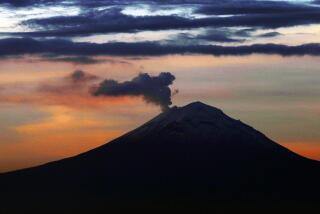Unexplored Venezuela Region Shrouded in Mist : Mystery Mountains Challenge Scientists
- Share via
CARACAS, Venezuela — Virtually impenetrable and unexplored, almost 625 miles south of Caracas, is a land of mysterious table-top mountains that is one of science’s great challenges.
Thought to have split from a huge land mass of which part is now Africa, the Roraima Formation in Venezuela’s Amazonas region has attracted growing interest for its unique flora and fauna.
Almost always covered in mist, the so-called Tepuis are giant geological and ecological anachronisms in a lost world that today’s scientists are anxious to explore.
“The Roraima Formation is one of the last truly unexplored areas on Earth and one where expeditions are constantly finding species new to science,” Armando Michelangeli, leader of Venezuela’s Terramar Foundation said.
Founded two years ago, Terramar has organized the first scientific expeditions with experts of various disciplines to a massive Tepui mountain called Marahuaca, rising sheer from the jungle to an average height of 9,000 feet.
Interest in Expeditions
The results have sparked excitement in scientific circles here, in the United States and in Europe. The Royal Geographical Society of London has shown interest in mounting a joint expedition.
Among the discoveries are two subspecies of bird--a wren and a sparrow--which are totally new to science, scores of new insect species, three types of poisonous snakes and so far unidentified rodents.
Other significant curiosities include an orchid previously seen only in the Chilean Andes, scorpion fossils and a male specimen of a dragonfly whose only other recorded specimen was a female found in Suriname 100 years ago.
But a phenomenon of the Marahuaca Tepui that really puzzles the scientists is the presence of numerous tracks proving the existence of deer on the summit.
“Marahuaca has never been climbed, and as far as we know its high perpendicular walls, rising in places almost 5,000 feet, make it inaccessible,” Michelangeli said.
Animals on Mountain
The animals may once have climbed like mountain goats, but scientists cannot exclude the possibility that they were isolated on the summit by erosion after the mountains surged up from sea level between 1 billion and 1.5 billion years ago.
The first Europeans to visit Marahuaca arrived in an expedition led by the 19th-Century naturalist Robert Schomburgk. Attempts to scale the summit, including one by an Everest veteran, have failed.
The Terramar expeditions have been mounted with minimum publicity, unlike a big two-year project farther south at Cerro Neblina in which the Royal Geographical Society is involved.
The 9,880-foot Neblina mountain, which straddles the Brazilian frontier and is the highest peak in that country, also revealed a treasure trove of botanical specimens.
Charles Brewer-Carias, a veteran Venezuelan explorer who organized the expedition in conjunction with the Smithsonian Institution, says the results have been outstanding.
“We have so far collected 21,000 botanical specimens, more than ever before on a single expedition,” he said in a recent interview.
Untouched by Man
The remoteness of Neblina and Marahuaca has given them unusual ecological systems virtually untouched by man where insects and reptiles previously thought extinct abound.
There are about 115 Tepuis in Venezuela and four or five similar formations in Suriname, Guyana and Colombia. Only South Africa has table-top mountains in similar numbers.
Michelangeli says only two of Venezuela’s Tepuis have been well explored. Terramar plans four expeditions to Marahuaca in 1985 to look for deer and explore how life forms have developed.
“One of the main goals of the expeditions will be to determine the ecology balance--and how the animals got there,” Michelangeli said.
Expeditions to Marahuaca face formidable logistical problems. On one of the first trips, it took a week to transport fuel by river to Terramar’s base at the Indian settlement of Culebra, a journey of 12 minutes by helicopter.
Tree of Life
The Yekuana Indians of the area believe Marahuaca to be sacred, representing a giant tree of life from which all plants and animals originate.
They make their blowpipes from a special reed called kurata that grows only at Marahuaca. Identified by Schomburgk, it is of such high quality that the Yekuana trade it with the Yanomani Indians in neighboring Brazil.
The mountain is almost always rain-sodden and inhospitable to expedition teams.
The almost constant rains make it hazardous for Terramar to fly to the summit by helicopter, the only way of reaching there, and measure the towering waterfalls.
“The only difference between the dry and rainy seasons is that in summer it rains every day, and in winter all day every day,” Michelangeli said.
More to Read
Sign up for Essential California
The most important California stories and recommendations in your inbox every morning.
You may occasionally receive promotional content from the Los Angeles Times.













